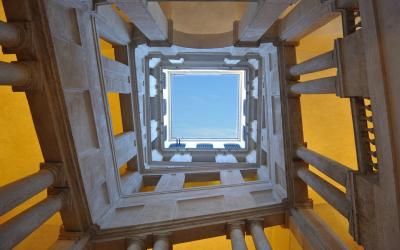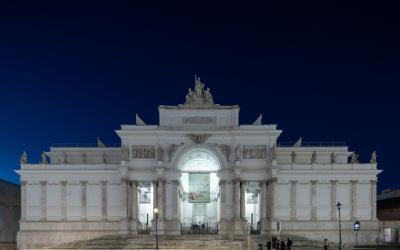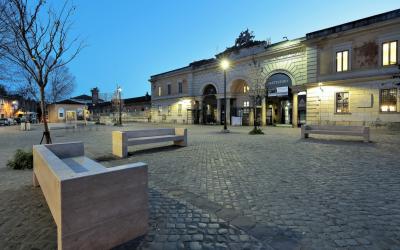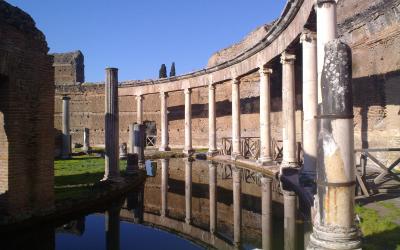The history of the Palace as a national museum, regularly open to the public, began in 1953, the year in which Palazzo Barberini became home to the National Gallery of Ancient Art along with Palazzo Corsini, which had been since 1895.
Over the years, Palazzo Corsini's collection had expanded through purchases and donations, such as the acquisition of the Torlonia and Monte di Pietà collections in 1892, the donation of Henriette Hertz in 1915, and the purchase of the Chigi collection in 1918. The expansion of the collections made the acquisition of new exhibition spaces essential, identified in Palazzo Barberini.
-
Opening days
from Tuesday to Sunday
-
Opening times
from 10.00 to 19.00
the ticket office closes at 18.00 -
Closing
Monday (except April 21, June 2 and December 8, 2025)
-
Extra Opening times
Special openings 2025:
Saturday, November 29th from 7:00 PM to 11:00 PM, with last admission at 10:00 PM (free admission). - Web Palazzo Barberini
-
Feature List
- Info line
- Wheelchair accessible
-
Accessibility
Entrance without architectural barriers.
Dogs, even small ones, are forbidden to enter, with the exception of guide dogs accompanying visually impaired people or unless a pet therapy certificate is presented.
Unlike the Corsini picture gallery, little remains of the original Barberini family collection. In the eighteenth century, in fact, the first dispersions began, partly because of disagreements between the various hereditary branches of the family, but above all in 1934 a Royal Decree was issued allowing the princes to sell, even abroad, most of their works. The state, in return, acquired a small nucleus of paintings, still identifiable by the initials "F" followed by progressive numbers (La Fornarina, for example, is initialed F1).
So while the Palazzo Corsini venue collects a historical picture gallery in its own right, the Palazzo Barberini presents a chronological and representative display of the main schools of painting from the thirteenth to the eighteenth centuries, organized so that new acquisitions can be integrated or different arrangements of the collection can be envisaged.
The sixteenth and seventeenth centuries are the most represented ones including works by Raphael, Piero di Cosimo, Bronzino, Hans Holbein, Lorenzo Lotto, Tintoretto, all the way to Caravaggio with the array of Caravaggeschi, and the rich seventeenth century with works by Gian Lorenzo Bernini, Guido Reni, Guercino, Nicolas Poussin, and Pietro da Cortona.
The 18th-century collection preserves important works by Maratti, Batoni, Canaletto, Subleyras, Mengs, and van Wittel; as well as paintings from the Duke of Cervinara's donation, with fine canvases by Fragonard and Boucher, and those from the Lemme donation, with rare sketches by Corvi and Ghezzi.
Maffeo Barberini (Florence 1568 - Rome 1644) was elected pope in 1623 under the name Urban VIII and two years later purchased for his grandchildren, who were invested with offices and honors, a villa on the Quirinal Hill formerly belonging to the Sforza family, and commissioned to Carlo Maderno (1556-1629), the new family palace. Instead of demolishing the villa, the architect incorporated it into a new architectural design: the Sforza wing, that is, the part of the building that faces the present Piazza Barberini, was connected to another wing, parallel to it, by a central arm. The new plan of the building has an absolutely innovative "H" shape. Maderno creates an open-wing structure that frames a vast garden, with rare plants, secret courtyards, and Italianate gardens.
Starting around 1620 numerous craftsmen worked on the interior decorations continuously until the mid-18th century, when the last direct heir, Cornelia Costanza, commissioned a Rococo-style apartment on the top floor. Descendants of the Barberini family lived in the palace's 18th-century apartment until 1955.
ITINERARY TOUR IN SHORT
Today it is possible to access the palace from Via delle Quattro Fontane through the porticoed façade, over which rises a faux glazed loggia, most likely designed by Gian Lorenzo Bernini (1598-1680), who succeeded Carlo Maderno in directing the building site in 1629.
DON'T MISS
The beating heart of the palace is the majestic reception hall frescoed by Pietro da Cortona. This monumental room can be accessed by a square well staircase, designed by Bernini, on one side, and by the extraordinary oval spiral staircase, probably designed by Francesco Borromini (1599-1667).
Services
-
Didactics for schools
Reservation for schools:
available in Italian, English, French, German, Spanish
from Monday to Friday, from 9.00 to 17.00: 848 082 408 and from mobile and abroad +39 0639967200
edu@coopculture.it -
Visits
Reservations for Groups
available in Italian, English, French, German, Spanish
from Monday to Friday, from 9.00 to 17.00: +39 639967450
tour@coopculture.it - Bookshop
- Wardrobe
Additional Info
- GROUPS
– each group must be composed of a maximum of 25 people, guide included;
– reservations are required both on weekdays and on weekends;
– the use of radio systems is mandatory;
– access is allowed to 2 groups every hour on weekdays and 1 per hour on weekends and holidays. In smaller rooms it could be limited to ensure compliance with the safety distance. To ensure the easiest use by all, the maximum time to stay in the museum is 2 hours.
– The supervisory staff has the right to urge the guides to move from the smaller rooms if the permanence of the group hinders the normal outflow of other visitors and, in extreme cases, may order the removal of the group; groups which, at the request of the staff, do not have a regular reservation will be removed without the possibility of a refund.
– Sanitizing gel and information on the rules to follow are available before entry and along the visit itinerary. The service areas, halls and common areas are repeatedly cleaned and sanitized.
- For schools, the reservation of the 25 seats in the shift is valid for the entire class group, upon presentation at the ticket office, on the day of the visit, of the COMPLETE list of class members, teachers included, on school headed paper, signed by the head teacher.
Where
via delle Quattro Fontane, 13 – 00184 Roma
Transportation
Train: to Termini Station, Metro line A, Barberini stop
Buses: 53 – 61 – 62 – 63 – 80 – 81 – 83 – 160 – 492 – 590
Giorgione from Budapest to Rome
From November 29, 2025, to March 8, 2026, Palazzo Barberini welcomes a special guest: the Portrait of a Young Man, also known as the Portrait of Antonio Brocardo and attributed to Giorgione, from the Szépmüvészeti Múzeum / Museum of Fine Arts in Budapest. The painting, created around 1503, comes to Rome as part of the exchange program initiated by the National Galleries of Ancient Art with important Italian and international institutions, offering the public a rare opportunity to experience the work of one of the most enigmatic masters of the Venetian Renaissance.








